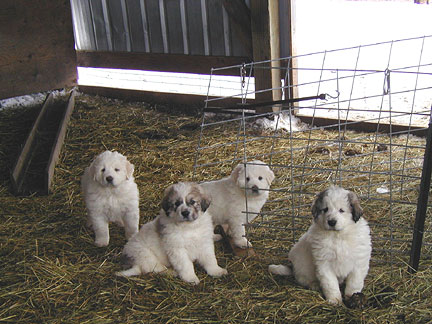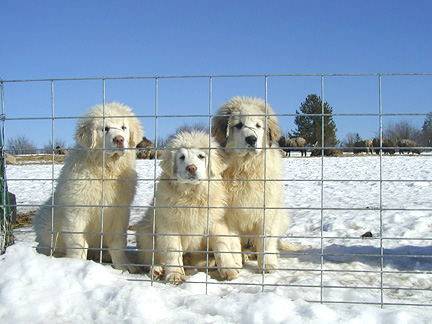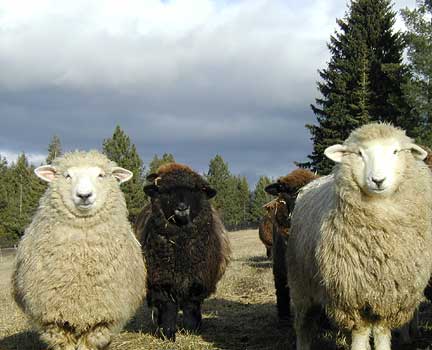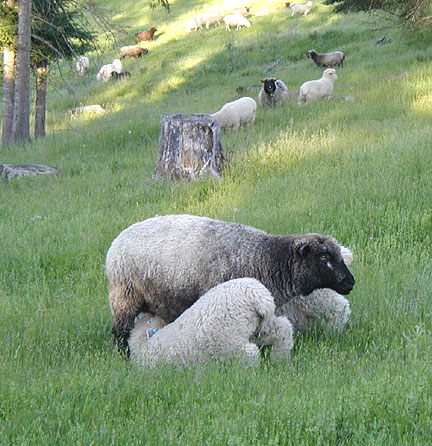|
|||
|
Contact |
GreatPyrenees
Livestock Guardian Dogs During summer 2007, the pups' serious schooling began when they joined the main flock (close to 200 sheep counting lambs) for the summer grazing season. Angus, Daisy, and the third SkyLines Pyrenees Vera helped fine tune the pups' training as they lived with the sheep 24/7, rotating through the farm's 63 acres of subdivided pastures. These pups are superbly healthy and vigorous animals. Both dam and sire's hips were X-rayed before breeding (at full maturity-two years), and both have excellent hips showing no sign for potential dysplacia. The pups will be available for sale as working LGDs starting fall-winter 2007. Call or write for more information on these dogs or to reserve a pup from our next litter. For details on my
livestock guardian dog training philosophy and methods,
check out Predator
Management. Four of the
five Angus-Daisy pups in the sheep barn at 6 weeks
of age (left to right: Stella, Buster, Maggie,
Ben). Two of the
five Angus-Daisy pups went to their new homes
SkyLines
Sheep Some of the
SkyLines Romney & Romney-cross ewe lambs, at
about 9 months of age. These grassfed beauties have
since matured and joined the SkyLines breeding
flock. SkyLines'
Sheep Breeding Program My Ideal Sheep . .
. SkyLines Market and Products . .
.
My Specific Breeding Goals . . . 1) Conformation I look for a sheep with a sweet, open facial expression and nice personality, fabulous fleece, and the physical characteristics to be low maintenance and to perform well on grass. Basically, this means I want her to be medium sized, standing fairly low to the ground, with a wide midsection providing lots of room for forage, well spaced hips, and a straight, moderately long back. She's not a flashy show sheep, her beauty is in that she looks "sturdy" and "productive," while also sporting a heavy, long, gorgeous handspinning fleece. 2) Self-Sufficiency They almost always deliver their lambs during daylight hours and come inside the barn if it's foul weather, very rarely need lambing assistance, produce twins regularly, produce large amounts of rich milk, and take excellent care of their lambs from birth to weaning. Flock Records: In addition to pedigrees on every animal, I've kept very detailed lambing and flock health records since I began shepherding in 1992. This is extremely useful information to me. As one example, I was able to eliminate the dreaded middle-of-the-night barn checks beginning in 2000, when 8 years of records showed me that virtually everybody in the SkyLines flock lambs between the reasonable hours of 5am and 10pm and that I've had to assist in only 2-3% of births in my worst year (hurrah!). Result: These girls are so self-sufficient that I'm able to deal with lambing out 50-60-70 ewes by myself and friends say that I only get a little crankier than normal! 3) Lamb Growth Happily, the word is finally beginning to get out to the public why raising ruminant animals on grass alone provides significant benefits for the environment, for our animals, and for our own health. Note: Since this flock is still in transition to fully grassfed the breeding ewes still get a small amount of grain during the winter months. 4) Fleeces After years of continuously improving my fleeces through genetic selection and better management practices, more than half of each year's fleeces are now being reserved long before shearing day and the rest sell out within months after shearing. 5) Finally, I want sheep that are calm, even tempered, easy to manage and work with, stay together as a flock, stay inside my fencing, and are naturally resistant to foot rot and internal parasites. Running a Closed Flock . .
. The new registered Romney rams I've purchased have helped to broaden my available genetic pool, and beginning with the '06 breeding season I've used some rams of my own breeding as well. Caveat: Well, I did break down and purchase a ewe in 2006. She's from a breeder I know well and trust implicitly, and she's such a gorgeous, unusual color that I couldn't resist adding her genetics to my flock. I also purchased her brother to add to my breeding program. Photos and details about Sweetie and Bruno's fleeces can be found at Handspinning Fleeces for Sale.) Three Lines . .
. These lines give me the variety of fleece types that interest me the most, and that sell out to spinners every year (see Fleeces above).
Here's how SkyLines lambs grow
up, the natural way . . .
These lambs grow up strong and healthy with superb handspinning fleeces . . . on only mom's nutritious, full-of-life milk, the farm's rich green grasses, periodic doses of garlic, and a free choice salt-mineral-vitamin mix and organic kelp for trace minerals. Nothing else. No vaccinations (though vaccines are allowed under organic certification), no chemical wormers, no antibiotics, no growth hormones, and no supplemental feeds like grain to make them reach market weight in a big hurry. The selection process . .
.
By mid summer, I make my final decisions on the very best ewe and ram lambs of the year. These lambs I either keep for myself or offer for sale to other breeders. The rest become market lambs. Visit the sheep and their fleeces
online . . . To get a close look at the
exquisite, top-selling, handspinning fleeces produced by the
SkyLines flock, see the Handspinning
Fleeces pages. Consider adding SkyLines genetics to your own flock, for improved, heavy-shearing handspinning fleeces & fast growth on grass alone! Call or write for availability and to arrange for a farm visit.
|




